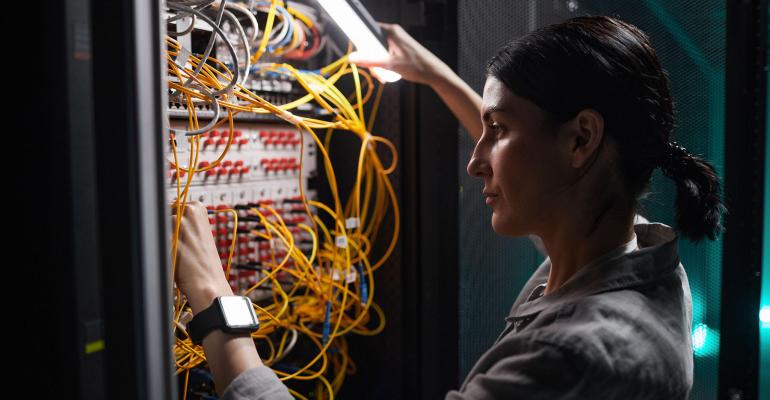While efforts to boost the recruitment of women in data centers have shown incremental progress, some women in the industry argue that addressing the gender imbalance requires more focus on retention, starting with tackling the male-centric culture and management’s failure to address inappropriate behaviors.
Often, the onus is placed on women to make advancements in the field by being confident, taking on increased responsibilities, and ‘tooting their own horns.’ However, this advice fails to adequately acknowledge that women are assessed differently at work than their male peers, as suggested by a 2015 paper from Stanford University’s Clayman Institute for Gender Research.
Women already face what scholars refer to as the “double bind” or “assertiveness penalty,” where societal expectations insist women must be both assertive and nurturing, confident but not overly aggressive. These hidden beliefs about a woman’s ability and aptitude factor into how they are treated.
Addressing Gender Bias in Data Centers for Better Inclusion
According to the Stanford study, women who display stereotypically ‘masculine’ leadership traits are less well-liked compared to men demonstrating similar traits. To attract and retain women in data centers, initiatives must be implemented to address harassment, prejudices, and gender bias in corporate environments.
“It’s training workers to be supportive, understanding and for them to know that the culture of work is different when women come in,” says Shanthi Rajan, CEO and founder of Linarc, a construction management software company.
Rajan notes that in both the construction and tech sectors, women are increasingly visible in various roles, including upper- and mid-management positions, as well as successful entrepreneurs. As more women enter at various levels, attitudes toward gender roles tend to change, resulting in an increased presence of women in the workforce.
When Rajan initially entered the tech industry, there was a noticeable gender imbalance, with a significantly higher proportion of men than women. And while she attributes her career development to the support she received from both male and female colleagues, Rajan suggests that if the data center industry aims to correct the DEI disparity, leaders must strive to level the playing field in terms of access and equity.
“It’s actually easier to run a business if your policies support every employee you have, whether it is flexible work, mentor support, or having work policies that are geared towards listening,” says Rajan.

To attract and retain women in data centers, initiatives must be implemented to address harassment, prejudices, and gender bias
Data Centers: Still a Short-Staffed Boys’ Club
In a recent report for the Uptime Institute, a data center certification association, research analyst Jacqueline Davis described the hiring environment in data centers as a “short-staffed boys’ club.” According to Uptime data, there has been minimal change to the employment landscape over the past few decades, with 50% of data centers reporting that their workforce has less than 5% women. This situation can exacerbate challenges related to misogynistic company culture.
Naiya Lammert, a former Navy nuclear electrician who was a front-line data center employee for several years, believes data centers are in such dire need of labor that they neglect to prioritize building an inclusive culture or implementing a zero-tolerance approach towards harassment and discrimination.
“Some guys are used to working with women and know better than to say, ‘She must be on her cycle,’” Lammert explained over Zoom. “[But others] don’t have experience working with women, and they’ve been allowed to get away with saying stuff like that, and [women] get labeled as being sensitive when they complain.”
When Lammert left the Navy, she quickly found employment at a data center business because the company was actively seeking to hire military veterans.
“Everybody was saying, ‘Come here, there’s money to be made,’” Lammert recalls. “They would hire us left and right. You could leave a data center in northern Virginia today and have another data center job tomorrow.”
She joined a large data center operator that was building a new site and hiring as fast as they could to meet increased demand. When Lammert started, she said she was one of only two women on a 25-person team. She got a promotion to team lead after a few months while the other woman had already left the job. According to Lammert, some of the men she supervised attempted to undermine her authority and refused to follow her directions or complete certain tasks unless she helped them. One man, Lammert alleges, threatened to confront her in the parking lot and told colleagues they needed to refuse her promotion because he deserved it instead.
Moreover, when she raised her concerns with her managers, Lammert recalls being consistently referred to as “Mama Naiya.”
“I was put into the maternal role where I have to take care of all those guys and ensure all their things are straight and it was frustrating and stressful,” she explains.
Despite her proficiency in managerial tasks, Lammert said she faced hurdles rooted in gender perceptions. She was informed that the men on her team disliked her communication style, highlighting the idea of systemic biases present in the workplace. These remarks were particularly distressing for Lammert, who wished to avoid being labeled as “the angry Black woman.”
Shedding light on the issue, a study by Harvard, Wharton, and MIT revealed the inherent biases in how men’s and women’s voices are perceived, with male voices often viewed as more persuasive, fact-based, and logical than women’s voices, even when expressed at identical pitches. The research underscores how the ‘double bind’ can hinder not only Lammert’s advancement but also countless others hoping for a career in the data center industry.
She left the company soon after.

Women are steadily becoming more visible in high-profile tech roles, which can inspire more women to join the industry
Towards a More Inclusive Data Center Industry
Mark Fong, CEO of Empyrion Digital, a prominent Asian data center operator in Asia, advocates for a fundamental shift in the approach to diversity and retention in the industry. He emphasizes the need to widen the recruitment net to include diverse talent pools, focusing on people with versatile skill sets and varied work backgrounds.
Fong said women have often-overlooked skills acquired in different industries which can seamlessly translate into the data center environment with additional in-house training if needed.
“We advocate personal and work-related training for our colleagues to help them upskill and develop their careers,” he said.
However, despite the potential benefits of such an approach, challenges persist within the industry, as illustrated by the experiences of individuals like Lammert.
She left the data center sector due to inflexible scheduling that conflicted with her childcare responsibilities, leading her to believe she was exiting the industry for good. However, a subsequent opportunity for a remote maintenance coordinator position in a data center reignited her career, giving her the schedule flexibility she needed for work-family balance.
Although Lammert said she now works for a company that she says fosters a more inclusive environment, she knows that systemic DEI issues still prevail across the data center industry.
“There are some hostile sharks in the water among regular fish, and they’re not doing anything to protect the rest of the group. They just say, ‘There’s sharks, and women just have to watch out.’”




